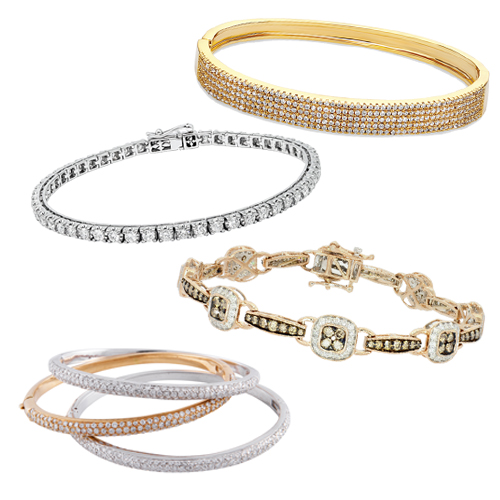Diamond Charm Bracelets
Charm bracelets are just the same as regular chain bracelets. However, charm bracelets carry ornaments or “charms” like pendants or trinkets. These charms typically carry sentimental value to their wearer.
History
Wearing charms began as a form of talisman or amulet to ward off misfortune and evil spirits. Prehistoric humans made their charms using animal bones, clay, and shells. Later on, they learned to use gems, rocks, wood, and metal in their jewelry.
Archeological evidence that dates back 75,000 years was found in the African continent that shells were utilized as adornments. A mammoth tusk with detailed carvings that date back to 30,000 years was found in Germany. Ancient Egyptians wore charms as symbols of luck and for identification. Charms were also used as identification for individuals so that gods may recognize them in the afterlife.
However, not everyone wore charms as bracelets. However, archaeological evidence shows that ancient Persians, Assyrians, and Babylonians wore charms as bracelets. Charms were worn as early as 600 BCE.
During the reign of Queen Victoria, charm bracelets were trendy amongst the European socialites. Queen Victoria is popular for giving out charm bracelets. Also, she was instrumental in the creation of “mourning” charms, which became popular when her husband Prince Albert died. Mourning charms are often charms that contain a small compartment that can accommodate the deceased’s lock of hair or a miniature portrait.
Tiffany and Co. launched their first charm bracelet in 1889. The bracelet is a simple chain bracelet with a heart hanging from it. The bracelet eventually became the most recognizable piece of jewelry for Tiffany today.
Types of Charms
Today, there are so many types and styles of charms that people can choose from. Below are the types of charms that are popular amongst individuals.
- Gemstone Charms add color and sparkle to the bracelet, especially diamond charms. The most popular type of gemstone charms used is in the form of birthstones.
- Symbols of luck are also popular, as certain religions and communities believe them to ward off evil and bring in good luck.
- Passion and hobbies charms represent an individual’s hobbies and passions. For example, a musician or music lover will have musical symbols or instruments as charms.
- Religion charms are charms that represent an individual’s religious belief.
- Relationship charms are charms that remind an individual of a relationship with someone, whether romantic, familial, or platonic.
We BUY Diamond Charm Bracelets
Do you have old diamond charm bracelets that you’re not using anymore and want out of your hands? We’ll be happy to take them from you and even pay you for them! Here at Nevada Coin Mart, we are the #1 buyer of diamond charm bracelets in Las Vegas and Henderson, even in the entire Nevada state!
We offer free in-store evaluation for your piece using a state-of-the-art Thermo Scientific Niton X-Ray Spectrometer in order to accurately analyze and measure precious metal contents in your piece. This will ensure that you get top-dollar for your items.
We are open 365 times a year from 9 am to 6 pm, so come visit us at Nevada Coin Mart® 4065 S. Jones Blvd Las Vegas, NV 89103 or call us up at 702-998-4000.








